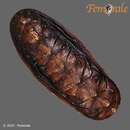en
names in breadcrumbs


Acanthochitonidae is a family of marine mollusks belonging to the class Polyplacophora, commonly known as chitons. Species are widely distributed throughout the world's oceans, but are most commonly found in the shallow waters of the Pacific Ocean, from Alaska to Chile.
Acanthochitonidae are characterized by a broad girdle covered in coarse spines with erect tufts of up to ten large bristles. The coarsely granular valves of the shell are partially overlapped by the girdle. The articulating flange, or articulamentum, is well developed. The margin of the cephalic plate has about five slits, and the lateral insertion plates all have a single notch. These small to large chitons have a distinctive appearance, and are easily recognizable by their characteristic spiny girdle.
Acanthochitonidae chitons are found in a variety of marine habitats, including rocky intertidal zones, coral reefs, and seagrass beds. They are also found in deep sea environments, with some species occurring as deep as 3,000 meters. Acanthochitonidae chitons are known to be active grazers, feeding primarily on algae and detritus.
Like other chitons, Acanthochitonidae are dioecious, meaning they have separate sexes. Fertilization is external, with males releasing sperm into the water, which is then taken in by females. The eggs are then fertilized internally and laid in capsules that are cemented to hard surfaces.
Acanthochitonidae chitons play an important role in marine ecosystems, serving as grazers and helping to maintain the balance of marine communities. They are preyed upon by a variety of predators, including sea stars, crabs, and fish.
Several species of Acanthochitonidae chitons are of conservation concern, particularly in areas where they are heavily harvested for food or decorative purposes. In some regions, they are also threatened by habitat destruction and pollution.
The family Acanthochitonidae includes approximately 80 species, distributed across 13 genera. Taxonomic classification within this family has been a subject of debate, with some species being moved between genera or reassigned to other families. Molecular phylogenetic studies have helped to clarify the relationships between different taxa within the family, and have led to the establishment of several new genera.
Acanthochitonidae chitons are not commonly featured in popular culture, but they have occasionally appeared in scientific documentaries and educational materials about marine life. They are sometimes kept in marine aquariums, where their distinctive appearance makes them popular among hobbyists.
According to the World Register of Marine Species (WoRMS) the following genera are included in this family:[1]
Acanthochitonidae is a family of marine mollusks belonging to the class Polyplacophora, commonly known as chitons. Species are widely distributed throughout the world's oceans, but are most commonly found in the shallow waters of the Pacific Ocean, from Alaska to Chile.